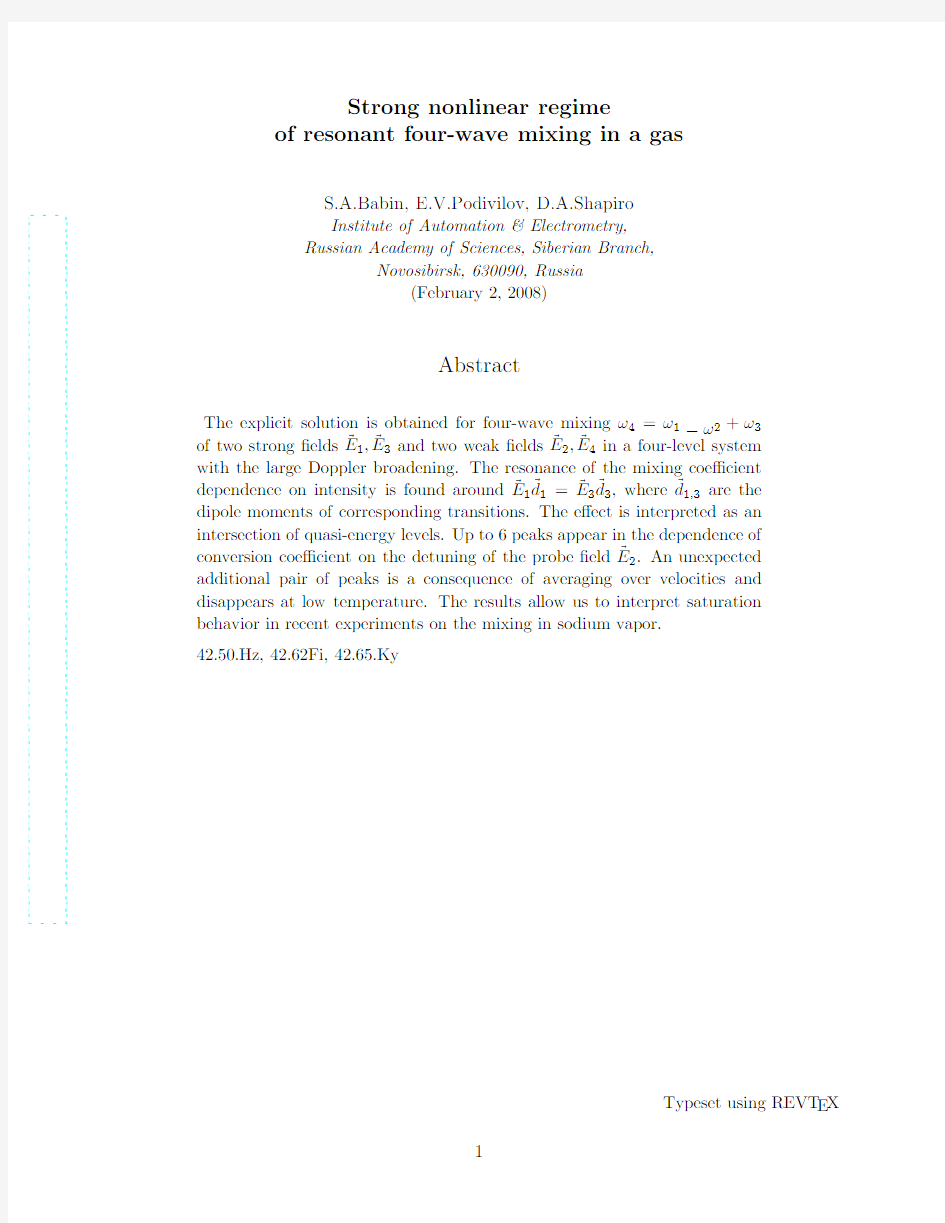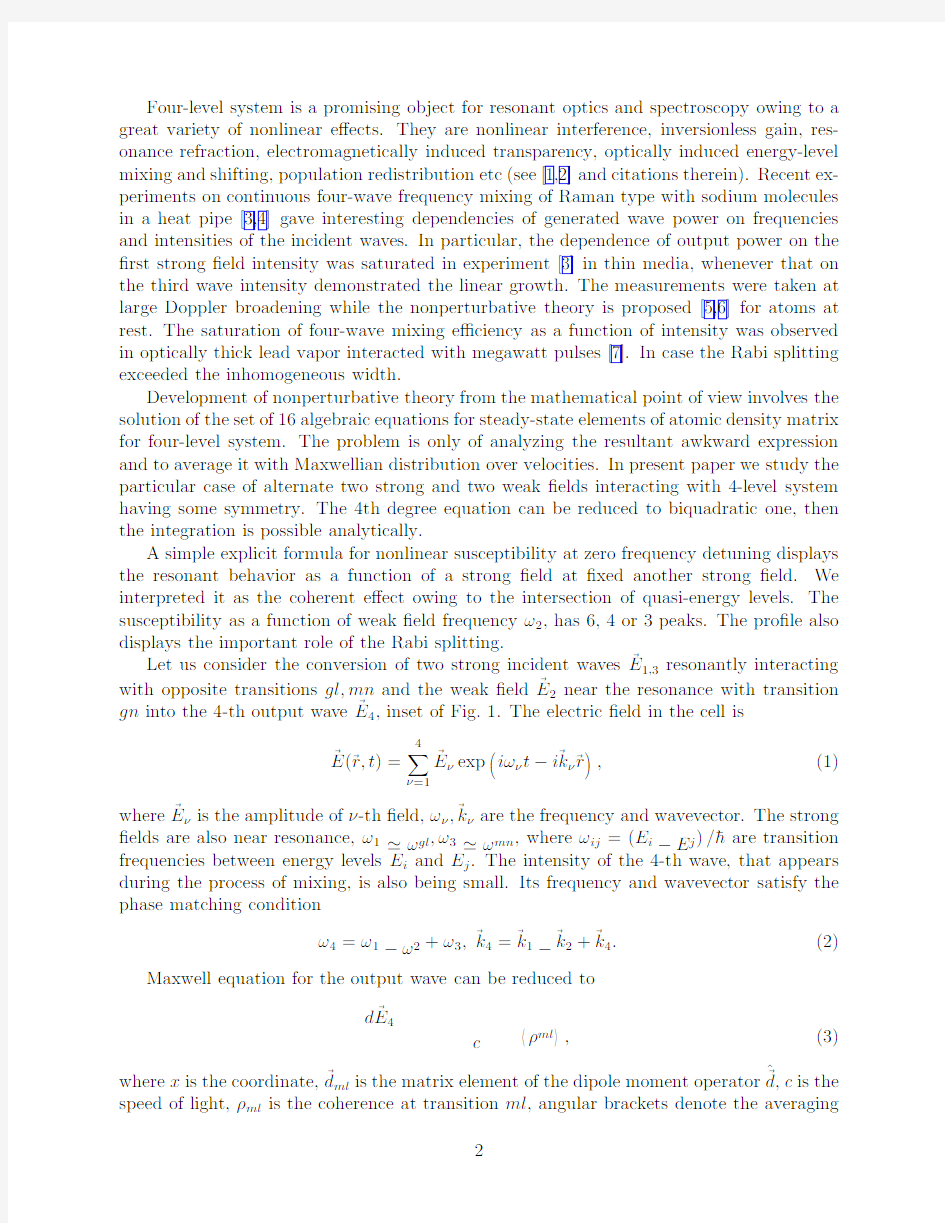Strong nonlinear regime of resonant four-wave mixing in a gas


a r X i v :p h y s i c s /9707003v 1 [p h y s i c s .a t o m -p h ] 4 J u l 1997
Strong nonlinear regime
of resonant four-wave mixing in a gas
S.A.Babin,E.V.Podivilov,D.A.Shapiro
Institute of Automation &Electrometry,Russian Academy of Sciences,Siberian Branch,
Novosibirsk,630090,Russia
(February 2,2008)
Abstract
The explicit solution is obtained for four-wave mixing ω4=ω1?ω2+ω3
of two strong ?elds E
1, E 3and two weak ?elds E 2, E 4in a four-level system with the large Doppler broadening.The resonance of the mixing coe?cient
dependence on intensity is found around E
1 d 1= E 3 d 3,where d 1,3are the dipole moments of corresponding transitions.The e?ect is interpreted as an intersection of quasi-energy levels.Up to 6peaks appear in the dependence of
conversion coe?cient on the detuning of the probe ?eld E
2.An unexpected additional pair of peaks is a consequence of averaging over velocities and disappears at low temperature.The results allow us to interpret saturation behavior in recent experiments on the mixing in sodium vapor.42.50.Hz,42.62Fi,42.65.Ky
Typeset using REVT E X
Four-level system is a promising object for resonant optics and spectroscopy owing to a
great variety of nonlinear e?ects.They are nonlinear interference,inversionless gain,res-onance refraction,electromagnetically induced transparency,optically induced energy-level
mixing and shifting,population redistribution etc(see[1,2]and citations therein).Recent ex-periments on continuous four-wave frequency mixing of Raman type with sodium molecules
in a heat pipe[3,4]gave interesting dependencies of generated wave power on frequencies
and intensities of the incident waves.In particular,the dependence of output power on the ?rst strong?eld intensity was saturated in experiment[3]in thin media,whenever that on
the third wave intensity demonstrated the linear growth.The measurements were taken at
large Doppler broadening while the nonperturbative theory is proposed[5,6]for atoms at rest.The saturation of four-wave mixing e?ciency as a function of intensity was observed
in optically thick lead vapor interacted with megawatt pulses[7].In case the Rabi splitting exceeded the inhomogeneous width.
Development of nonperturbative theory from the mathematical point of view involves the
solution of the set of16algebraic equations for steady-state elements of atomic density matrix for four-level system.The problem is only of analyzing the resultant awkward expression
and to average it with Maxwellian distribution over velocities.In present paper we study the particular case of alternate two strong and two weak?elds interacting with4-level system
having some symmetry.The4th degree equation can be reduced to biquadratic one,then
the integration is possible analytically.
A simple explicit formula for nonlinear susceptibility at zero frequency detuning displays
the resonant behavior as a function of a strong?eld at?xed another strong?eld.We
interpreted it as the coherent e?ect owing to the intersection of quasi-energy levels.The susceptibility as a function of weak?eld frequencyω2,has6,4or3peaks.The pro?le also
displays the important role of the Rabi splitting.
Let us consider the conversion of two strong incident waves E1,3resonantly interacting with opposite transitions gl,mn and the weak?eld E2near the resonance with transition
gn into the4-th output wave E4,inset of Fig.1.The electric?eld in the cell is
E( r,t)=4 ν=1 Eνexp iωνt?i kν r ,(1) where Eνis the amplitude ofν-th?eld,ων, kνare the frequency and wavevector.The strong
?elds are also near resonance,ω1?ωgl,ω3?ωmn,whereωij=(E i?E j)/ˉh are transition frequencies between energy levels E i and E j.The intensity of the4-th wave,that appears
during the process of mixing,is also being small.Its frequency and wavevector satisfy the phase matching condition
ω4=ω1?ω2+ω3, k4= k1? k2+ k4.(2) Maxwell equation for the output wave can be reduced to
d E4
c ρml ,(3) where x is the coordinate,
d ml is th
e matrix element o
f the dipole moment operator? d,c is the speed of light,ρml is the coherence at transition ml,angular brackets denote the averaging
over velocity distribution.We should calculateρml as a function of input amplitudes E1,2,3, their wavevectors k1,2,3and frequency detuning of the weak?eld.
For this end we solve the equation for Wigner’s atomic density matrix(see[8])
?
,
γl(Γ2s1+?′21)
2|G1|2γ1
ρg=N g+N1
;
Γ2s1+?′21
ρn=N n?N32|G3|2γ3
,(6)
γm(Γ2s3+?′23)
iG3N3Γ?3
ρ3=
Γ2ρ2?iG 1ρ?6+iG 3ρ5
=?iG 2(ρg ?ρn ),
Γ?4ρ?4+iG ?3ρ?6?iG ?1ρ5
=iG ?4(ρm ?ρl ),
(7)
Γ5ρ5?iG 1ρ?4+iG ?
3ρ2
=iG 2ρ?3?iG ?
4ρ1,
Γ?6ρ?6+iG 3ρ?4?iG ?1ρ2
=?iG 2ρ?1+iG ?
4ρ3.
Here γ2≡γgn ,γ4≡γml are the constants of relaxation of the coherence at the allowed
transition,γ5≡γgm ,γ6≡γnl are the constants for forbidden transitions,?′5=?′1??′4,?′6=?′1??′2are frequency detunings at these transitions.
The solution of Eq.(7)
for the
nondiagonal element at output transition ml can be presented as
ρ?4=?iβ4G ?1G 2G ?3?iα4G ?
4.
(8)
During the initial step of the mixing the generated ?eld is small,|G 4|?|G 2|,that enables
one to neglect the absorption α4and to ?nd the coe?cient β4only.We found intensity of output wave within the thin medium approximation by the integration of Eq.(3)from x =0to the length of cell L
I 4(L )=
2π2ωml L
D
(Γ5+
Γ?6)(ρg
?ρn )?
ρ?1
iG ?3
(|G 3|2?|G 1|2?Γ2Γ?6)
.
(10)
Here elements ρg ,ρn ,ρ1,ρ3are de?ned by Eq.(5),(6),the determinant of set (7)is
D =Γ2Γ5Γ?4Γ?6+(|G 1|2?|G 3|2)
2
+1
2
(|G 1|2?|G 3|2)(Γ2?Γ?4)(Γ5?Γ?6),
(11)
the polynomial of 4th degree in velocity.The averaging of coe?cient β4over velocity is
possible by the residues theory for the Doppler limit v T →∞.
To examine the intensity dependence of coe?cient β4let us consider the case of equal relaxation constants of the levels γj =γ,j =g,l,m,n ,excitation of the lower level only Q j /γ=Nδjl ,the resonant strong ?eld detunings ?1/k 1=?3/k 3?v T ,and equal wavenum-bers of both weak ?elds |k 2?k 4|?(k 2k 4k 5k 6)1/4.The last condition is natural in down-conversion scheme.In view of phase matching condition (2)it is felt that the weak ?eld detunings depend on single parameter ?:?2=k 2?1/k 1+?,?4=k 4?1/k 1??.Within the
assumptions one can also see that k 4=k 2,k 6=k 5.If all the wavevectors are parallel,then the expression for β4 assumes a simple form
β4 =
N πv T
e ??21/k 21v 2
T
∞
?∞C (x )
Γ2s 1+k 21x
2
,(12)
C (x )=
4|G 1|2iz
+(γ?ik 1x )×
|G 1|2
?|G 3|2
?(γ?i (k 2x ??)(γ?i (k 5x ??))
.
Here x = k 2 v /k 2??1/k 1,z =??iγ,Γ2s 1=γ2+4|G 1|2
is the saturated width.Determinant D (x )turns to be a function of x 2
D (x )=κ4x 4?2κ2x 2
?1+
?22,
κ=
π
Γ2s 1+Γs 1Rμ+?2μ2
γ+izμ2
?2
1
Γs 1
,(15)
where R =
μ2?1.
The value | β4 |2at the exact resonance ?ν=0,ν=1,...,4is shown in Fig.2as a function of |G 1|2.The sharp peak at |G 1|=|G 3|con?rms the qualitative interpretation
of the e?ect as the intersection of quasi-energy levels.Inset in Fig.2illustrates why the maximal conversion occurs when the Rabi splitting in opposite two-level systems are equal.
Here the cross-transition from the upper sublevel of level m to the upper sublevel of level n has the same frequency as the transition between their lower sublevels.In this case only
3resonances remain in the spectrum,Fig.1(c),with the overpowering maximum in the center.The resonance condition|G1|=|G3|brings the maximum conversion e?ciency in the intensity dependence.
The splitting e?ect is evident from experimental results on resonant four wave mixing in Na2[3,4].The main feature is the saturation of output power as a function of one strong?eld. The conditions of experiment[3]are generally satisfy the above model:(1)down-conversion level schemeω4<ω1(see inset,Fig.1)with k1v T=7.0·109s?1,k2v T=6.5·109s?1,k3v T= 5.2·109s?1,k4v T=5.7·109s?1;(2)all incident waves1,2,3are generated by external lasers;
(3)the region of interaction is short enough(nearly1cm),the model of thin media can be treated;(4)estimated level parameters are N l~1012cm?3?N n~1011cm?3?N g,N m,γm?γg~2·108s?1,γn?γl~2·107s?1.Slightly noncollinear geometry(mixing angle θ~10?2)leads to an e?ective broadening?ω~kv T·θ~108s?1.Another factor is usual jitter of laser frequencies,especially for dimer and dye lasers,?ω~(2÷4)·108s?1.Thus,the e?ective valueγ=(3÷6)·108s?1seems reasonable;(5)the maximal?eld values estimated from the focusing geometry|G1|max~109s?1,|G2|max~2·108s?1,|G3|max~5·108s?1 nearly correspond to the condition of two strong?elds.
The resonance condition|G1|=|G3|may result in peaks as in dependenceβ4(I1),as in dependenceβ4(I3).If|G1|max>|G3|max,the peak is seen only inβ4(I1).The width of the peak is determined by the decay rateγ.Since in the experimentγ~|G3|,the peak is wide,Fig.2(b),and gives a smooth saturation curve I4(I1),Fig.2(c).According to this consideration the saturation of I4(I1)in the experiment(boxes in Fig.2)is observed at |G1|>|G3|and there is no saturation for I4(I3).Note that such behavior was observed for di?erent values of I2varied by one order.Under the opposite experimental condition [4]|G1|max<|G3|max the dependencies I4(I1)and I4(I3)change their behavior in agreement with the consideration.
Thus,the model explains quantitatively the main features of the measured saturation curves.To observe the sharp resonances arising from Rabi splitting the stabilization of laser frequencies seems to be important.To increase the e?ciency of conversion into the4th wave it is necessary to tune up the laser frequencies to corresponding peaks.The optimum at ?ν=0corresponds to equal Rabi frequencies|G1|=|G3|.
Authors are grateful to S.G.Rautian,A.M.Shalagin,and M.G.Stepanov for fruitful discussions,B.Wellegehausen and A.A.Apolonsky for clarifying the details of experiments. This work was partially supported by Deutsche Forschungsgemeinschaft,grant WE872/18-1.
REFERENCES
[1]M.O.Scully,Phys.Rep.219,191(1992).
[2]O.Kocharovskaya,Phys.Rep.219,175(1992).
[3]S.Babin,U.Hinze,E.Tiemann,and B.Wellegehausen,Opt.Lett.21,1186(1996).
[4]A.Apolonsky et al.,Appl.Phys.B64,435(1997).
[5]A.Popov,Bull.RAS,ser.phys.60,99(1996).
[6]D.Coppeta,P.Kelley,P.Harshman,and T.Gustavson,Phys.Rev.A53,925(1996).
[7]M.Jain et al.,Phys.Rev.Lett.77,4326(1996).
[8]S.Rautian and A.Shalagin,Kinetic Problems of Non-Linear Spectroscopy(Elsevier,
Amsterdam,1991).
LIST OF CAPTIONS
Fig. 1.Conversion coe?cient| β4 |2(arb.units)as a function of detuning?of the second?eld at|G1|=1,|G3|=0.5,k1v T=7.0,k2v T=6.9,γ=0.2(a),γ=0.02(b),and γ=0.02at|G1|=|G3|=0.5(c)(all frequencies are in ns?1).Inset is the level diagram of four-level system interacting with two strong driving?elds at the opposite transitions(solid arrows)and two weak?elds(wavy arrows).Dotted lines show the forbidden transitions. Fig. 2.Conversion coe?cient| β4 |2(arb.units)vs|G1|2at|G3|=0.5,?=0, k1v T=7,k2v T=6.5:γ=0.06(a),γ=0.6(b),and|G4|2vs|G1|2atγ=0.6(c).The parameters for(b),(c)correspond to experiment,all frequencies are in ns?1.Boxes denote the experimental points from[3].The inset illustrates the Rabi splitting of dressed states.
